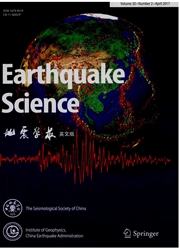

 中文摘要:
中文摘要:
The eastern Tibetan plateau has been getting more and more attention because it combines active faults,uplifting, and large earthquakes together in a high-population region. Based on the previous researches, the most of Cenozoic tectonic activities were related to the regional structure of the local blocks within the crustal scale. Thus,a better understanding of the crustal structure of the regional tectonic blocks is an important topic for further study. In this paper, we combined the simple Bouguer gravity anomaly with the Moho depths from previous studies to investigate the crustal structure in this area. To highlight the crustal structures, the gravity anomaly caused by the Moho relief has been reduced by forward modeling calculations. A total horizontal derivative(THD) had been applied on the gravity residuals. The results indicated that the crustal gravity residual is compatible with the topography and the geological settings of the regional blocks,including the Sichuan basin, the Chuxiong basin, the Xiaojiang fault, and the Jinhe fault, as well as the Longmenshan fault zone. The THD emphasized the west margin of Yangtze block, i.e., the Longriba fault zone and the Xiaojiang fault cut through the Yangtze block. The checkboard pattern of the gravity residual in the SongpanGarze fold belt and Chuandian fragment shows that the crust is undergoing a southward and SE-directed extrusion,which is coincident with the flowing direction indicatedfrom the GPS measurements. By integrating the interpretations, the stepwise extensional mechanism of the eastern Tibetan plateau is supported by the southeastward crustal deformation, and the extrusion of Chuandian fragment is achieved by Xianshuihe fault.
 英文摘要:
英文摘要:
The eastern Tibetan plateau has been getting more and more attention because it combines active faults,uplifting, and large earthquakes together in a high-population region. Based on the previous researches, the most of Cenozoic tectonic activities were related to the regional structure of the local blocks within the crustal scale. Thus,a better understanding of the crustal structure of the regional tectonic blocks is an important topic for further study. In this paper, we combined the simple Bouguer gravity anomaly with the Moho depths from previous studies to investigate the crustal structure in this area. To highlight the crustal structures, the gravity anomaly caused by the Moho relief has been reduced by forward modeling calculations. A total horizontal derivative(THD) had been applied on the gravity residuals. The results indicated that the crustal gravity residual is compatible with the topography and the geological settings of the regional blocks,including the Sichuan basin, the Chuxiong basin, the Xiaojiang fault, and the Jinhe fault, as well as the Longmenshan fault zone. The THD emphasized the west margin of Yangtze block, i.e., the Longriba fault zone and the Xiaojiang fault cut through the Yangtze block. The checkboard pattern of the gravity residual in the SongpanGarze fold belt and Chuandian fragment shows that the crust is undergoing a southward and SE-directed extrusion,which is coincident with the flowing direction indicatedfrom the GPS measurements. By integrating the interpretations, the stepwise extensional mechanism of the eastern Tibetan plateau is supported by the southeastward crustal deformation, and the extrusion of Chuandian fragment is achieved by Xianshuihe fault.
 同期刊论文项目
同期刊论文项目
 同项目期刊论文
同项目期刊论文
 期刊信息
期刊信息
